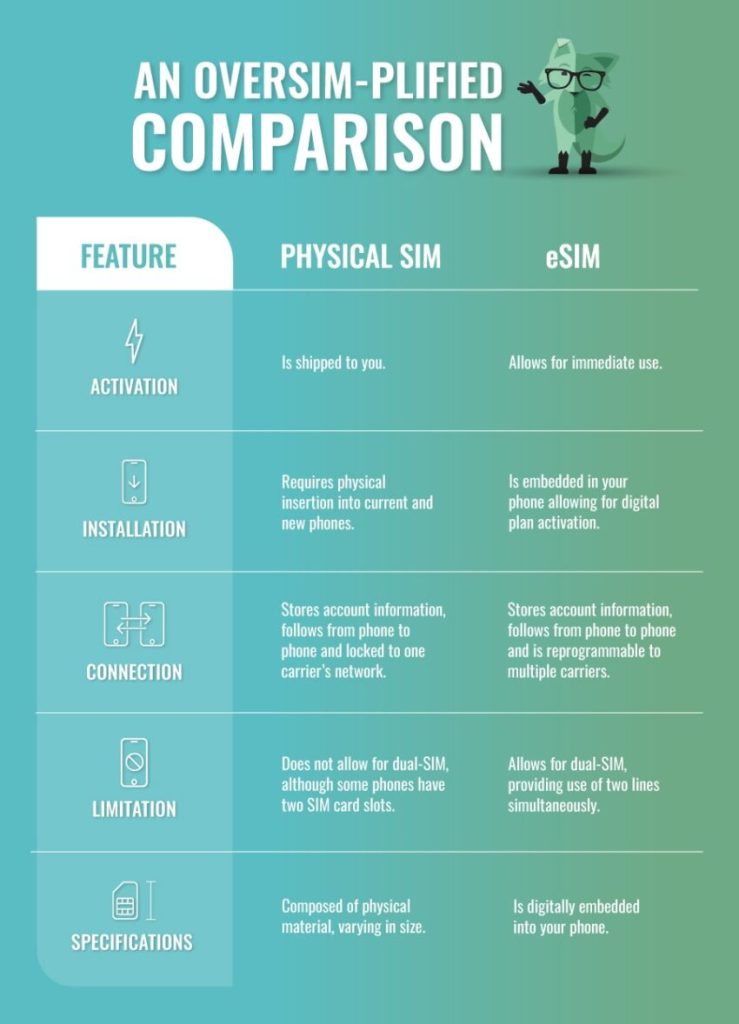what’s the difference between esim and physical sim
• What is ESIM?
• What is a Physical SIM?
• Advantages of ESIM
• Disadvantages of ESIM
• Advantages of Physical SIM
• Disadvantages of Physical SIM
• How Does an ESIM Work?
• How Does a Physical SIM Work?
• What Are the Benefits of an ESIM Compared to a Physical SIM?
• What Are the Drawbacks of an ESIM Compared to a Physical SIM?
Esim (Embedded SIM) and Physical SIM (Subscriber Identity Module) are two types of sim cards used in mobile devices today. An Esim is an electronic card that is embedded directly in the device and does not need to be physically inserted or removed. A Physical SIM, on the other hand, is a physical card that needs to be inserted into the device. Both can be used to store personal information, data plans and access to cellular networks. However the main difference between them is that an Esim does not need to be changed when switching providers, while a Physical SIM does.ESIM (Embedded SIM) is a form of SIM card that does not need to be physically removed from the device in order to switch operators or change the associated phone number. This type of SIM card is embedded into the device and connects wirelessly to a mobile network, eliminating the need for a physical SIM card.A Physical SIM (Subscriber Identity Module) is a physical card that contains information about a mobile network subscriber, such as their phone number, billing information, and other data. It is used to identify and authenticate subscribers on a mobile network. The SIM card is inserted into the mobile device and acts as an electronic key that unlocks the device’s access to the network. Physical SIMs are typically issued by mobile operators and have become the standard for identifying subscribers on cellular networks around the world.
Physical SIMs are secure and reliable, providing users with added protection against unauthorized access to their personal
Advantages of ESIM
The use of embedded subscriber identity modules, or eSIMs, provides several advantages over traditional SIM cards. For starters, eSIMs are more secure than physical SIM cards, as they are stored on a secure chip in the device and can not be easily swapped out. This makes them ideal for IoT applications where device security is paramount. Additionally, eSIMs are also more cost-effective than physical SIM cards as they can be remotely programmed and updated which eliminates the need for costly hardware replacements or upgrades.
Advantages of ESIM
ESIM (Embedded Subscriber Identity Modules) is an advanced technology that offers a wide range of advantages for mobile device users. It allows them to store their personal data securely on their devices, including SIM and USIM cards, without having to worry about the security of their information. ESIM also offers users the convenience of being able to use multiple SIMs in a single device, allowing them to switch between different networks without having to carry multiple physical SIMs. Additionally, ESIM enables users to access and manage their data from
Advantages of Physical SIM
One of the main advantages of using a physical SIM card is the increased security it provides. With a physical SIM card, users can be sure that their data is not being accessed or stored by anyone else. This is because the user’s data is encrypted and stored on the physical card, meaning that it cannot be intercepted or accessed by anyone else. Furthermore, physical SIM cards are much more difficult to replicate than virtual SIM cards, making them much more secure and reliable.
Another advantage of using a

Advantages of Physical SIM
Physical SIM cards have a number of advantages when compared to other mobile networks. The most obvious advantage is that physical SIM cards are more secure and reliable than other methods of connecting to the internet. This is because physical SIM cards are physically installed into the device, making it harder for hackers to gain access to your data. Additionally, physical SIM cards provide better signal strength and coverage than other methods, meaning that you won’t experience any dropped calls or slow speeds. Finally, physical SIM cards offer a range of services depending on the provider
What is an ESIM?
An eSIM, or embedded SIM, is a type of SIM card that is embedded into a device such as a smartphone or tablet. Unlike a physical SIM card that can be removed from the device, an eSIM cannot be removed and must remain in the device it was purchased with. An eSIM works by connecting to cellular networks, allowing users to access voice and data services without needing a physical SIM card. The technology was developed in an effort to reduce the need for physical SIM cards and make it easier for users to switch carriers without having
How Does a Physical SIM Work?
A physical SIM, or Subscriber Identity Module, is a small card that contains information that mobile networks use to identify and authenticate subscribers. The SIM card stores a user’s personal data, such as their phone number, address book contacts, preferences and text messages. It also provides access to network services like voice calls, SMS messaging and mobile data. When you insert a physical SIM into a compatible device, the mobile network identifies your device and authenticates it through the SIM card. Once authenticated, you can access the

Conclusion
The main difference between eSIM and physical SIM is that eSIM is embedded on the device, whereas physical SIM needs to be inserted into the device. An eSIM is more convenient as it eliminates the need for specialised hardware or visiting a shop to switch carriers. However, physical SIMs offer more flexibility in terms of network coverage and data plans.
In conclusion, eSIMs are ideal for consumers who are looking for convenience and don’t want to go through the hassle of inserting a physical SIM card. On the other hand, physical SIM cards provide


